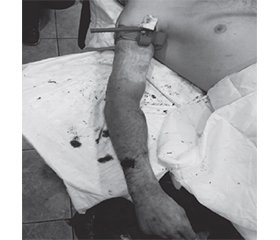Журнал «Травма» Том 26, №4, 2025
Вернуться к номеру
Оцінка ефективності та ризиків застосування турнікетів у ЗСУ під час бойових дій в Україні
Авторы: V.V. Chorna (1), А.М. Hrynzovskyi (2), S.І. Kalashchenko (2), S.Yu. Nesterova (3), L.B. Lototska (4), A.M. Hubar (5)
(1) - Vinnytsia National Pirogov Memorial Medical University, Vinnytsia, Ukraine
(2) - Bogomolets National Medical University, Kyiv, Ukraine
(3) - Vinnytsia Mykhailo Kotsiubynskyi State Pedagogical University, Vinnytsia, Ukraine
(4) - Danylo Halytsky Lviv National Medical University, Lviv, Ukraine
(5) - Ukrainian Military Medical Academy, Kyiv, Ukraine
Рубрики: Травматология и ортопедия
Разделы: Клинические исследования
Версия для печати
Актуальність. Масивні кровотечі залишаються однією з провідних причин смертності військовослужбовців у збройних конфліктах, що зумовлює постійну потребу у вдосконаленні засобів тимчасової зупинки кровотечі. Турнікет типу CAT (combat application tourniquet) продовжує залишатися стандартом тактичної медицини завдяки доведеній клінічній ефективності, високій швидкості накладання та надійності в умовах бойових дій. Його використання суттєво знижує летальність при травмах із критичними кровотечами з кінцівок, особливо на догоспітальному етапі надання медичної допомоги. Мета: проаналізувати вплив застосування турнікетів (джгутів) військовослужбовцями у випадках масивної/критичної кровотечі, травматичних ампутацій кінцівок, а також оцінити своєчасність проведення конверсії у світі та Україні. Матеріали та методи. Роботу виконано шляхом систематичного огляду, метааналізу, контент-аналізу статей у наукометричних базах Scopus, PubMed, ResearchGate. Пошук літератури здійснювався з використанням ключових слів «tourniquet», «stop the bleeding». У дослідження були включені описи клінічних випадків накладання турнікетів (джгутів) військовослужбовцями ЗСУ, ретроспективні аналізи та огляди літератури. Після проведення огляду статей та ознайомлення з їх повними текстами відібрано 8 джерел. Пошук даних виконано за період 2012–2025 рр. Дослідження проводили на базі одного хірургічного госпіталя (Role 2) у квітні — травні 2024 року та квітні — травні 2025 року. Проаналізовано застосування засобів тимчасової зупинки критичних кровотеч, їх доцільність, тривалість та ризики ускладнень у 135 військовослужбовців, які перебували в зоні бойових дій. Результати та висновки. Тривалість накладання засобів гемостазу в більшості випадків (60,0 % у 2025 p., зростання на 10 % порівнянo з 2024 р.) перевищує 2 години, а застосування турнікетів понад 3 години (збільшення частоти на 5,0 % у 2025 р. проти 2024 р.) свідчить про тривалу евакуацію поранених унаслідок інтенсивних бойових дій, що, у свою чергу, підвищує ризик ішемічних ускладнень та вимагає ретельного клінічного моніторингу. У 70,0 % випадків для зупинки кровотечі достатньо одного турнікета, тоді як у 30,0 % виникає потреба у застосуванні двох і більше, що свідчить про тяжчий характер поранень, зумовлений модернізацією та підвищеною вражаючою здатністю сучасного озброєння. Ішемічні ускладнення фіксуються майже в половині випадків, головною причиною є тривале накладання турнікета.
Background. Massive bleeding remains one of the leading causes of death among military personnel in armed conflicts, which leads to a constant need to improve the means of temporary bleeding control. The combat application tourniquet continues to be the standard in tactical medicine due to its proven clinical effectiveness, high speed of application and reliability during hostilities. Its use significantly reduces mortality in injuries with critical bleeding from the extremities, especially at the pre-hospital stage of medical care. The purpose was to analyze the impact of using tourniquets by military personnel in cases of massive/critical bleedings, traumatic amputations of limbs, and to assess the timeliness of the conversion in the world and in Ukraine. Particular attention is paid to the rationale for the expediency and inexpediency of using tourniquets, the duration of application, as well as the study of possible complications associated with their excessive or untimely use during intense hostilities and delays in evacuating the wounded. Materials and methods. The work was carried out through a systematic review, meta-analysis, content analysis of articles in the scientometric databases Scopus, PubMed, ResearchGate. The literature search was carried out using the following keywords: “tourniquet”, “stop the bleeding”. The study included descriptions of clinical cases of applying tourniquets by the servicemen of the Armed Forces of Ukraine, retrospective analyses and literature reviews. After reviewing the articles and reading their full texts, 8 sources were selected. The search covered the period from 2012 to 2025. The study was conducted based on one surgical hospital (Role 2) in April-May 2024 and April-May 2025. The use of means to temporary stop critical bleeding, its appropriateness, duration and risks of complications were analyzed in 135 servicemen who were in the combat zone. Results and conclusions. The duration of hemostasis in most cases (60.0 in 2025 %, an increase by 10 % vs. 2024) exceeds 2 hours, and the duration of tourniquet use exceeding 3 hours (compared to 2024, the frequency has increased by 5.0 % in 2025) indicates a prolonged evacuation of the wounded as a result of intense hostilities, which, in turn, increases the risk of ischemic complications and requires careful clinical monitoring. In 70.0 % of cases, one tourniquet is enough to stop the bleeding, while in 30.0 %, two or more tourniquets are required, which indicates the more severe nature of the wounds caused by the modernization and increased destructive power of modern weapons. Ischemic complications are recorded in almost half of the cases, the main reason for which is the prolonged application of a tourniquet.
турнікет (джгут); масивна/критична кровотеча; ішемічні ускладнення; військовослужбовці ЗСУ
tourniquet; massive/critical bleeding; ischemic complications; military personnel of the Armed Forces of Ukraine

